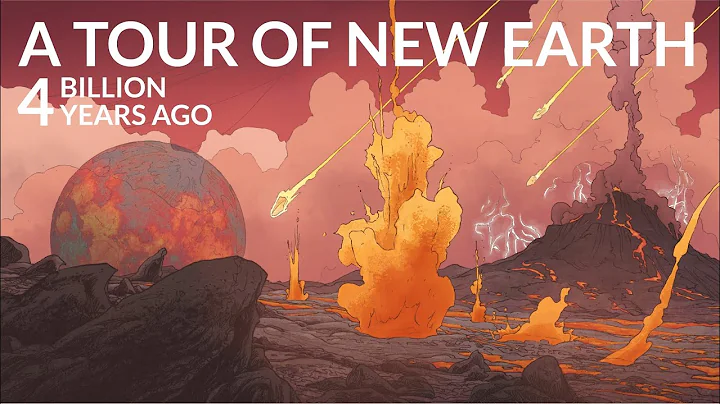The earth is often called the "blue planet" because there is a large amount of water resources distributed on this planet. The ocean area accounts for about 71% of the earth's area, and the land area only occupies about 29% of the earth's total area. , it can be seen that the ocean is the most important component on the earth .

Once upon a time, our ancestors rode a small boat and swam on the West Lake, listening to the chirping of seabirds and watching the waves of the water; Today, our technology has advanced rapidly, and we took the Endeavor into the water and sailed across the five oceans to catch turtles.
With the development of science and technology, we humans have become more and more comprehensive in our exploration of the ocean, and our understanding of marine life is becoming more and more abundant. At present, only about 5% of the places in the world are mysterious corners that we humans have not yet explored, and These corners are basically all over the ocean.

Therefore, when we explore the new world of the ocean, we often have mixed feelings. Among them, there is both excitement about exploring unknown areas and fear of ocean giants.
So, how terrifying is 10,000 meters under the sea? Many brave divers are afraid of this place.

Underwater World
With the passage of time, our human science and technology has also developed to a peak. Therefore, we already have enough scientific and technological strength to be able to explore the world's deepest trench- Mariana Trench.
This trench is 11,034 meters deep, and the water pressure increases the further you go down. Moreover, it is very Hunan, with very low temperature and oxygen content. It is one of the most hostile areas on the earth. In 2020, my country's "strugglers" The successful ranking proves our country’s scientific and technological strength.
This diving trip is not only a test of our country's technology, it is also a double test of the diver's mental ability and physical fitness.
- The photosynthesis zone
The place 200 meters from the water surface to is called the " photosynthesis zone " by the scientific community. Here, sunlight can shine directly through the water surface. Therefore, many people live here Plankton .
When we came to the location 40 meters underwater, we could see many professional divers swimming here. They were wearing special diving suits and carrying a variety of professional equipment. The water pressure was not too high.
continues to sink. When we come to the position of 100 meters underwater, we can see hairtail fish with their heads facing upwards and slowly appearing. They swing their bodies and look for food in the vast ocean.

When we came to our senses, the detector had brought us to the position 200 meters underwater, this is the deepest place where the ocean light can shine.
Under the faint light, here presents a beautiful scenery. Fish are swimming freely, shells are slowly opening, and some corals and seaweed located here are gently swaying with the water waves.

- The mid-ocean zone
The light becomes dim at 200 meters to 1000 meters underwater. This is called the "mid-ocean zone" by the scientific community. Here, our submersible will turn on the searchlight to reveal the light to us. Uncover the mystery here.
When we reach 300 meters underwater, we will obviously feel the increase in ocean water pressure. The average pressure is equivalent to a weight of about 600 kilograms. However, with the help of the submersible, we are not affected by this.

When we arrive at 500 meters underwater, we have a chance to see the blue whale, the largest overlord in the ocean. They live at the intersection of cold and warm sea water, with a length of up to 33 meters and a weight of more than 180 tons. Considered the largest mammal on earth.
When it opens its mouth, everyone will subconsciously feel afraid of , but this fear is completely unnecessary. Although the blue whale looks like a huge existence, its throat is very small, only 20-20 in diameter. 30 cm, therefore, it only eats small fish, shrimps and plankton.

As the submersible gradually deepened, we came to , 1000 meters underwater. The surroundings were pitch black without any light. Therefore, this place is also regarded as the transition area between shallow sea and deep sea. The wonderful thing is that here Creatures have lived in darkness for a long time, but have evolved the ability to illuminate.

- Deep sea zone
Within the range of
- 000 meters to 1600 meters , many ugly-looking marine creatures are swimming wantonly. There are " blanket octopuses " with their own "blanket", and there are also some that have lived on the earth for 3.8 years. Billion-year-old frilled shark.
- Abyssal Zone
- Super Abyssal Zone
When we come to
- 600 meters deep, we are likely to see glass octopuses with transparent bodies, swimming freely like a floating elf.

Continue to dive, we came to the depth of 1760 meters of the ocean, sperm whales and king squid live here . They are huge and are natural enemies of each other. Every time they meet, they will cause violent fluctuations.

At 2,500 meters underwater, we can see the existence of submarine volcanoes, and if we observe carefully, we can also see these volcanoes spewing bursts of green smoke, but strictly speaking, this is not smoke. But hot water.
Due to volcanoes and earthquakes, the rock layers on the seafloor cracked.. The cold seawater on the seafloor poured into the depths of the earth's crust. After being heated, it formed such hot water and spewed out from under the earth's crust.

4000 to 5000 meters under the ocean. This is the real abyssal zone. The creatures here have lived in the dark abyss without seeing the sun for a long time. Therefore, their visual organs have suffered serious degradation and basically only Can rely on touch to perceive the underwater world.
When we are 5,000 meters under the sea , the water temperature here is close to freezing point, and ugly-looking fang-tooth fish live here.

The part below 6,000 meters underwater is called the "Ultra-Abyssal Zone" . The water temperature here is extremely low and the pressure is quite high. Not only do we have difficulty breathing and the brain is deprived of oxygen, but also There will be symptoms of vomiting and dizziness.
html Between 17,000 meters and 8,000 meters , the huge water pressure is enough to crush super weapons on the surface into scrap metal, but there are still many fish that have adapted to this huge water pressure and live here.

About 8150 meters underwater, we have reached the maximum depth for fish survival. There are very few animals that can survive at this depth. Among them is a very cute lion fish. It is white and chubby, but its Extremely powerful in combat, it is the apex predator deep in the Mariana Trench.
Finally, we arrived at a location 10,000 meters below the sea. The water pressure here has basically reached its maximum value. It is equivalent to 1,000 atmospheric pressure, just like 2,000 elephants stepping on a person.

Through the narration, we have a simple understanding of the depth of 10,000 meters underwater. , the water pressure here is quite high, and there is basically no light. The endless darkness swallows us, and marine species There are also sounds of fish swimming around from time to time.
Although our "Endeavour" deep submersible has reached the depth of the Mariana Trench, which is more than 10,000 meters, , as a deep trench, the bottom of the Mariana Trench is 6-11 kilometers long. Therefore, we have There is still a lack of comprehensive understanding of this 10,000-meter-deep trench, and this fear of the unknown is also something that divers must bear.
In summary, 10,000 meters under the sea is definitely a restricted area that is unimaginable for humans. Whether it is strange creatures, strong air pressure , or cold sea water and an environment with extremely low oxygen content, it is a place that is difficult for humans to reach. If Without the protection of deep submersible , we humans would be completely unable to reach such a place.

Conclusion
With the development of science and technology, we humans have been able to independently explore most areas of the world , but there are still many places full of unknown fear, and the environment there is incompatible with the conditions required for human survival. Understanding these areas is still a long process.
As time goes by and technology improves, our divers will eventually explore the "horrifying picture" of the deep seabed.
















